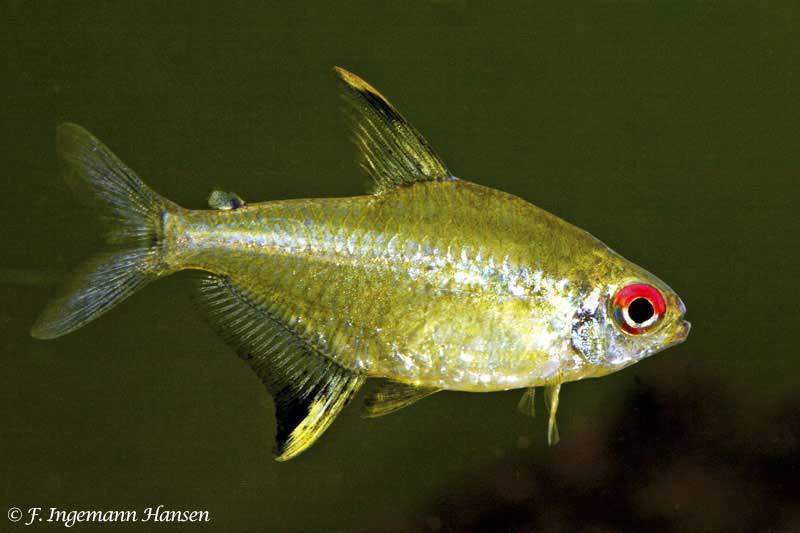Hyphessobrycon pulchripinnis – Lemon Tetra
Hyphessobrycon pulchripinnis was described in 1937 by Ernst Ahl. Their common name is Lemon Tetra.
The genus name Hyphessobrycon can be broken down into two ancient Greek words. Hyphesson means “a little smaller” and “bryko” means biter. Together they form the genus name “Small biter”. The species name pulchripinnis can be broken down into two Latin words. Pulcher means ‘beautiful’ and pinna means ‘fin’. A reference to the beautifully colored black/yellow back and anal fins.
Description
The Lemon Tetra is a nice colored fish that unfortunately is rarely kept. Due to the stress of transport, they often turn grey in the store, so they are easily overlooked in the shop. After a week or two in a planted aquarium, the colors will start to show.
Hyphessobrycon pulchripinnis can reach a maximum length of about five centimeters. The body is semi-transparent. On the back, it has a yellow-brown color which changes downwards into a soft lemon yellow. The dorsal and anal fins have a white/lemon yellow tip that clearly contrasts with the black in these fins.

Origin
South America; Brazil
The Aquarium
Because they do not grow very large, they are very suitable for a smaller aquarium. However, they are schooling fish that should be kept with at least 5 to 6 conspecifics. So make sure that there are not too many fish in the aquarium. Preferably, you should also make sure that you keep more females than males. A ratio of one male to two females is ideal. The males can be recognized by the slightly wider black margin in the dorsal and anal fin and they are slightly larger than the females.
To make the colours stand out, it’s best to use a dark bottom and filter the water over peat (also lowers the pH slightly, which these fish will certainly appreciate). Some floating plants are also appreciated. Furthermore, the usual border plants between which they can retreat. They are active fish but do not swim very fast.
Breeding Lemon Tetra
Breeding is somewhat difficult in the community tank. They are egg eaters who are happy to look for some tasty eggs after spawning A separate breeding tank works best.
You can use a small aquarium from 50x30x30 centimeters. The bottom can remain bare or contain 2-3 layers of marble. Bring the pH of the water to around pH 6.5 with a temperature of 23 degrees Celsius. The eggs are laid between fine-leaved plants such as Java moss or Myriophyllum. Most eggs don’t really stick and fall to the bottom very quickly. With a bare bottom, the parents must be removed immediately after spawning, otherwise, they will eat the eggs if they can find them. When using marbles you have a little more time. The eggs fall in between, making it impossible for the parents to reach them.
Raising the Young Hyphessobrycon pulchripinnis – Lemon Tetra
The eggs of the Lemon Tetra hatch after 24 to 48 hours and the fry then live on their yolk sac for another 2 to 3 days. After 4-5 days they can swim freely and you can start feeding them with infusion, liquifry and other small food. After about ten days they could also be fed fine dry food.
The young Hyphessobrycon pulchripinnis are very sensitive. The water must be absolutely clean, so regular changes are necessary. They also cannot withstand temperature fluctuations. When changing water, make sure that water has been prepared in advance and it that has already been brought up to temperature.
Video
Author
John de Lange
Copyright images
John de Lange
F. Ingemann Hansen – Akvariefotografen.com
References



















Reviews
There are no reviews yet.